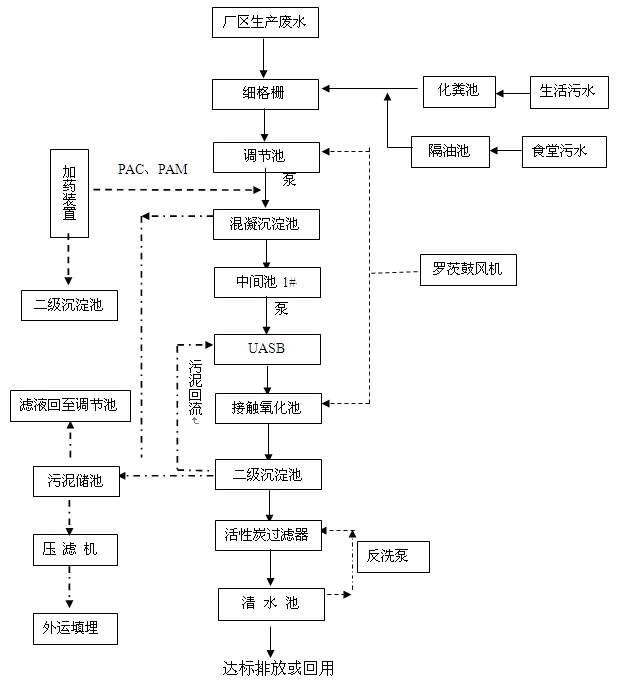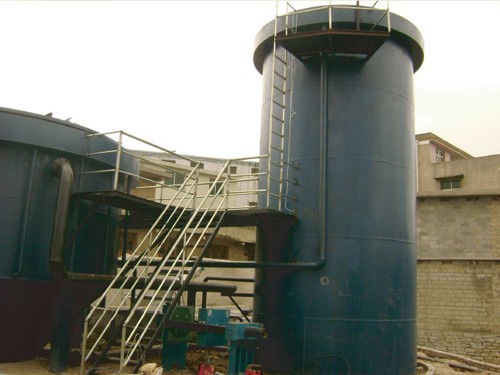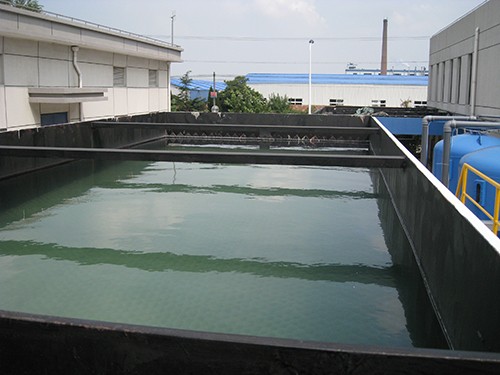Project Description: Ningbo Zhenhai Food Factory is a comprehensive market-oriented economic entity with agricultural and sideline food trade as the leader. It is mainly engaged in the processing and sales of moon cake, egg yolk pie series, sesame stick, Tianjin twist, Weimeixin, crispy corner, and rot. The main raw materials are flour, eggs, sugar, vegetable oil, seasonings, etc. These food production processes mainly include: leather material preparation, processing of filling filling, plastic forming, external dressing, swaying, baking, and cooling packaging. The wastewater in the production process is mainly equipment washing wastewater and employee catering wastewater. The total amount is about 200 tons/day, and the water pollution indicators include CODcr, BOD5, SS and vegetable oil. The company actively called for the corresponding national call and entrusted our company (Ningbo Jingyuan Membrane Technology Co., Ltd.) to design and construct the wastewater treatment project. It is required to return some of the sewage to the miscellaneous water used in the plant area, and the other part to achieve the standard discharge, to achieve “energy saving and emission reduction” and reduce pollution.
The company's 200 tons / day wastewater treatment project, the design of integrated wastewater influent water quality is as follows:
| Name | Unit | Index value |
| CODcr | mg/l | ≤3500 |
| BOD5 | mg/l | ≤1500 |
| pH | - | 5-6.5 |
| SS | mg/l | ≤350 |
| Animal and vegetable oil | mg/l | 30-40 |
After the treatment, the wastewater of animal and vegetable oils is superior to the effluent and implements the Class A standard of Pollutant Discharge Standards for Urban Sewage Treatment Plants (GB18918-2002), which realizes partial recycling and partial discharge. The specific indicators of the standard are as follows:
| Name | Unit | Index value |
| CODcr | mg/l | ≤50 |
| BOD5 | mg/l | ≤10 |
| pH | - | 6-9 |
| SS | mg/l | ≤10 |
| Animal and vegetable oil | mg/l | 1 |
Introduction to the project process:

Project process description:
The waste water discharged from the workshop passes through the fine grid to remove part of the large food residue, and then enters the regulation tank. Because the drainage method is intermittent drainage, the water volume is adjusted in the adjustment tank, and the adjustment tank is provided with a perforated aeration tube. By assisting agitation and pre-aeration, the sewage will adjust the water volume and homogenize the water quality through the time in the pool to ensure stable and continuous operation of the subsequent treatment section. The wastewater in the adjustment tank is lifted from the pump to the coagulation sedimentation tank, and the coagulation sedimentation tank is used for the dosing reaction to remove a part of the suspended matter and the colloidal substance, and the oil substance, and the effluent of the coagulation sedimentation tank flows to the intermediate mixing tank, and is added. Nutrient and adjust the temperature to about 34 °C to improve the treatment efficiency of UASB. The water in the intermediate mixing tank is pumped to the UASB anaerobic reactor. The UASB reactor is separated from the reaction zone, the inlet pipe and the three-phase separation. The reactor consists of a high-concentration, high-activity sludge bed at the bottom of the reactor. The sewage passes through the UASB from bottom to top. Most of the organic pollutants in the wastewater are degraded into methane and carbon dioxide by anaerobic fermentation. The upper part of the reactor is provided with a three-phase separator for separating the digestive gas, the digestive juice and the sludge particles. The digested gas is led out from the top of the reactor; the sludge particles are automatically slipped and settled to the sludge bed at the bottom of the reactor; the digestive juice is discharged from the clarification zone into the contact oxidation pond, and the CODcr and BOD5 in the water are removed by the biodegradation of aerobic microorganisms. , ammonia nitrogen and other pollutants. The aerobic tank effluent further removes SS and part of the organic matter after the dosing reaction, and the treated water flows into the secondary settling tank for sludge water separation. The water separated by the muddy water of the secondary sedimentation tank flows into the sand filtration system to remove the SS that has not settled from the secondary sedimentation tank, and the effluent enters into the clear water tank, and finally the effluent can be reused or discharged to the standard within the plant.
Project Photo: UASB Reactor in System Operation



Scan It